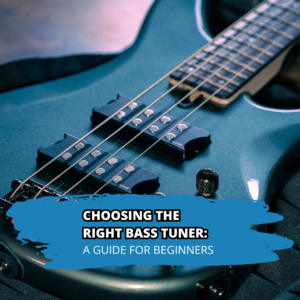Choosing the Right Bass Tuner: A Guide for Beginners

Bass tuners are indispensable tools for musicians, ensuring that their instrument produces accurate and harmonious sounds. Proper tuning is foundational to both practice and performance, making tuners vital for bassists of all skill levels. Bass tuners come in multiple forms, each designed to meet different needs and preferences.
Importance of Tuning Your Bass
Tuning your bass guitar is crucial for ensuring the best sound quality and playability. A well-tuned bass allows for clearer notes and more cohesive performances. Beginners especially can benefit from using a bass tuner, as it teaches them the essential skill of recognizing correct pitch. Regular tuning also maintains the integrity of your music, preventing off-key sounds during practice or performance. For those new to bass guitars, understanding the value of a precise tuner can significantly enhance your learning experience and overall musical enjoyment.
Overview of Bass Tuner Types
There are several types of bass tuners available to musicians, each with its own set of features tailored to different needs. Clip-on tuners are popular for their convenience and portability, attaching directly to the bass’s headstock. Pedal tuners are a favorite among professionals for their precision and ability to mute the signal while tuning. Smartphone app-based tuners provide a modern solution, offering tuning capabilities through a device that is often already in a musician’s pocket. Each type offers unique advantages, and selecting the right bass tuner depends on your personal circumstances and performance requirements.
Types of Bass Tuners
The variety of bass tuners available today reflects the diverse needs and environments of bass guitar players. From compact, simple-to-use devices to more sophisticated units incorporating cutting-edge technology, each type of bass tuner offers unique benefits.
Clip-On Tuners
Clip-on tuners are a favorite among many bassists due to their ease of use and portability. These tuners work by sensing the vibrations of the instrument, which means they can provide accurate tuning even in noisy surroundings. They are small, easy to carry, and can be quickly attached to the headstock of your bass. For beginners, clip-on tuners are an affordable and effective choice to keep their instrument in tune.
Pedal Tuners
Pedal tuners are designed for more experienced players who perform live. These tuners are part of a pedalboard setup, allowing bassists to tune silently between songs during a gig. They are highly accurate and visible in various lighting conditions, making them an indispensable tool for performing musicians. Although pedal tuners might be more expensive, their durability and precision make them a worthwhile investment for serious bass players.
Smartphone App-Based Tuners
Smartphone app-based tuners are a modern solution for tuning instruments. These apps are generally less expensive than dedicated hardware tuners and can be extremely convenient since they are always accessible on your phone. While they may not be as accurate as clip-on or pedal tuners, they are sufficient for beginners or as a backup option. Additionally, these apps often come with extra features such as metronomes and chord libraries, making them a versatile tool for new musicians.
Choosing the Right Bass Tuner
Selecting an appropriate bass tuner is a critical decision for any musician, impacting both the quality of sound and the ease of tuning.
Considering Your Needs
When choosing a bass tuner, consider your specific situation. If you often play in noisy venues, a clip-on or pedal tuner might be the best choice due to their ability to tune based on vibrations rather than sound. For beginners, simplicity and ease of use should be priorities, guiding them towards clip-on models or smartphone apps that provide visual aids and straightforward functionality.
Assessing Features and Accuracy
Accuracy is paramount when selecting a bass tuner. Look for tuners that offer precision tuning, with a clear display of whether the bass is sharp, flat, or in tune. Features such as multi-mode tuning, which allows for different tuning scales, and a true bypass in pedal tuners that prevents tone loss, can greatly enhance your tuning experience. Additionally, consider tuners that come with additional functionalities like metronomes or sound libraries for an all-in-one solution.
Budget Considerations
Your budget will largely dictate the type of bass tuner you can afford. Clip-on tuners are generally the most affordable, while pedal tuners are on the higher end of the price spectrum. However, investing in a more expensive tuner can be worthwhile for the accuracy and durability it offers, especially if you perform frequently.
Using Your Bass Tuner Effectively
Efficient use of a bass tuner is a skill that enhances a musician’s ability to quickly and accurately tune their instrument.
Basic Steps to Tune Your Bass
To get started with your bass tuner, begin by plugging in or clipping it to your instrument. Ensure each string is tuned to the standard bass tuning of E-A-D-G. For most tuners, simply pluck a string and adjust it based on the tuner’s feedback until it shows that the string is properly tuned. Repeat this process for each string, checking and fine-tuning as necessary to ensure the best sound.
Tips for Tuning in Noisy Environments
Tuning in noisy environments can be challenging. In such cases, using a clip-on tuner or a pedal tuner can be advantageous as they pick up vibrations directly from the instrument rather than relying on sound. Ensure that your tuner is firmly attached and sensitive enough to detect the correct vibrations. Additionally, standing away from noise sources and using a tuner with a vivid display can help improve accuracy under these conditions.
Elite Music Academy: Bass Lessons in Toronto
Our academy provides an environment where students can thrive musically, equipped with the right tools and guided by experienced instructors.
No Commitment Lessons
We offer comprehensive bass lessons tailored to each student’s skill level and musical goals. With no commitment required, beginners can explore bass guitar at their own pace, under the guidance of experienced instructors. Our lessons not only include practical playing techniques but also cover essential music theory. Joining Elite Music Academy is a great way to begin your musical journey with the bass guitar. Discover firsthand experiences from our music community by exploring our reviews!
FAQs
1. Can tuning my bass frequently affect its strings?
Regular tuning will not harm your bass strings; it ensures the best possible sound and performance stability.
2. How do I decide between a clip-on bass tuner and a pedal bass tuner?
Consider your playing environment and needs: clip-on bass tuners for ease and portability, pedal tuners for live performance precision.
3. How accurate are smartphone app-based tuners compared to hardware bass tuners?
While generally less accurate than dedicated hardware bass tuners, smartphone app-based tuners provide sufficient accuracy for beginners or as a backup option.
4. What additional features should I look for in a smartphone app-based bass tuner?
Look for features like a built-in metronome, chord libraries, and visual tuning aids, which can assist beginners in more than just tuning.
5. Is it better to tune with an electronic tuner or by ear?
While tuning by ear is a valuable skill, electronic bass tuners provide a quick and accurate method, making them ideal for beginners and professionals alike.






